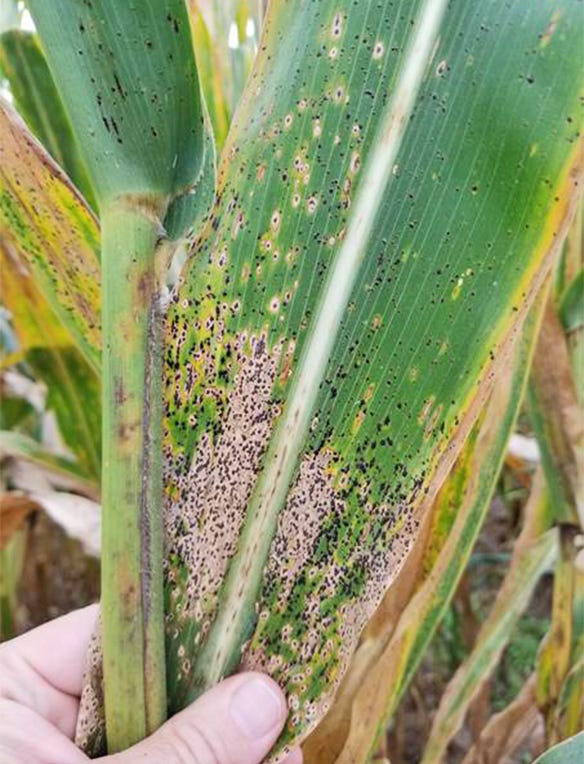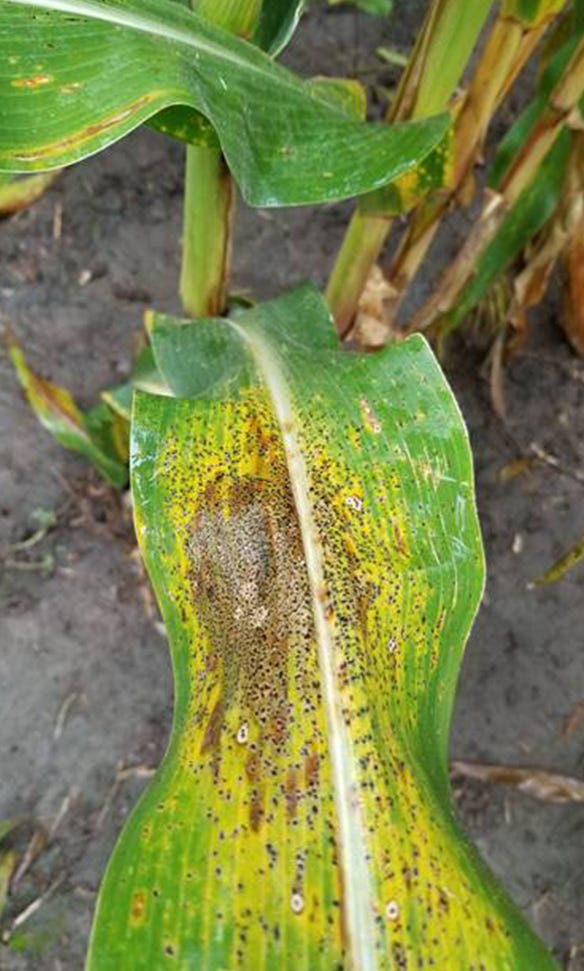
An unusually wet and humid summer has caused corn across the southern part of Wisconsin to be impacted by many fungal diseases, including a little-known and fairly new disease called tar spot.
Tar spot has been more common in Central America and South America. It was first found in the U.S. in 2015 near DeKalb in northern Illinois. In 2016 and 2017, the disease was identified in Green, Iowa, Grant and Lafayette counties in southwestern Wisconsin, according to Extension agronomists at University of Wisconsin-Madison. In 2018, confirmations have been made in these same general areas, but also have expanded to include reports from Eau Claire and Columbia counties, and on the eastern side of the state in Fond du Lac and Calumet counties.
Severity ranges from simple cosmetic damage to early death of entire fields, says Vince Davis, technical service representative for BASF for Wisconsin and northern Illinois.
“It’s almost an epidemic in southwestern Wisconsin, northern Illinois and eastern Iowa,” he says. “It’s blowing up in northern Indiana and southern Michigan, as well.”
What is tar spot?
“Tar spot looks like you flicked tar on corn plants,” Davis says. “It is a fungus. If the disease interacts with other diseases like gray leaf spot and northern corn leaf blight, it can affect stalk strength and yield.”
This is the first year the disease will have a large economic impact.
“Where it comes into fields, it kills the corn plant prematurely,” Davis says. “We’re seeing bad stalk quality.”
Davis says excess rain and flooding in the southern half of the state in August and September contributed to the problem.

SPREADING FAST: Tar spot is a fairly new disease in the U.S. It was found near DeKalb, Ill., in 2015. It first appeared in southwestern Wisconsin in 2016 and 2017. In 2018, it has spread to other counties in Wisconsin and across several Midwestern states.

“The biggest thing for the 2018 crop is for growers to evaluate cornstalk health and get the crop out of the field as early as possible,” he says. “I think we are going to have a lot of standability issues this fall. They need to harvest corn as early as they can.”
Davis advises growers to have someone evaluate their fields for tar spot disease.
“This is a new disease of U.S. corn growers, so seed companies have not focused on hybrids that are immune to tar spot,” he says. “One of the biggest keys is to evaluate yield, stalk quality and standability. I would suggest growers take notes on all of those issues for next year. I suggest they spend more time evaluating their own fields for plant health and stalk quality. Every grower should familiarize themselves with what this disease looks like. It’s here, and it’s not going away. It has spread to larger geographies every year.”
Davis says tar spot is going to cost some growers 30 to 40 bushels in yields this year. “In some fields the yield loss is very devastating,” he notes.

VARYING DAMAGE: The severity of the disease ranges from simple cosmetic damage to early death of entire fields.

Davis says there is evidence that fungicides help control the disease.
“We have data from Central America that it can be controlled with a fungicide. But it looks like it can hit a lot earlier or later than we are used to seeing other infection issues in plants,” he says. “We may have to change our fungicide application timing to control tar spot. Historically, most fungicide is applied around tasseling time. However, we’re going to likely see changes in application timing depending on the onset of the disease. This disease could mean changing the way we raise corn.”
Davis says agronomists are seeing some really big differences for growers who applied fungicides this year.
Will tar spot be worse in 2019?
For growers wondering what next year holds, Davis points out that every year is different.
“I tried to get a lot of growers to apply fungicide this year,” he says. “We had a lot of humidity this year. We had perfect disease conditions for much of the summer in 2018. Those who applied fungicides will see a great benefit, especially those who applied fungicide before and during tasseling.”
This was a tough disease year for Wisconsin corn growers, not only because of tar spot, but also because northern corn leaf blight and gray leaf spot were big issues. Although tar spot is new, it is important to keep plants as healthy as possible from all diseases so when a new disease such as tar spot emerges, the plant is healthy and better able to defend itself, Davis says.
Davis recommends farmers who are concerned they may have tar spot in their corn next season talk to an agronomist or Extension agent to determine the best time to apply fungicide.
About the Author(s)
You May Also Like






